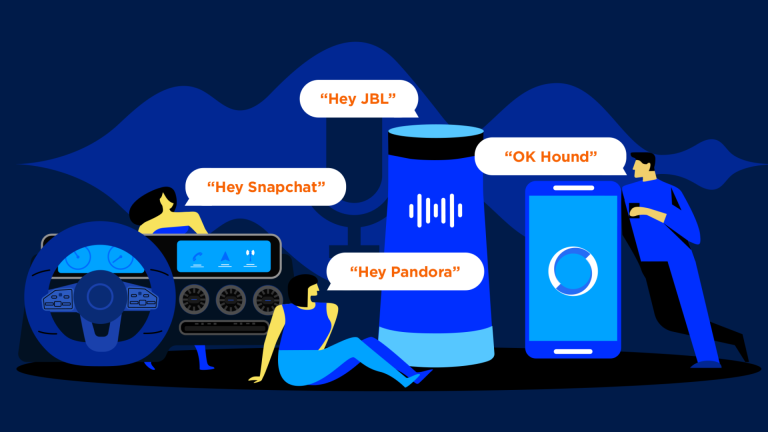
5 Keys to Elevating Customer Experiences with a Branded Voice Assistant
How to implement a voice assistant that reflects your brand’s uniqueness and attributes, while delivering exceptional customer experiences.
Products
Our Platform
SoundHound’s independent voice AI platform is built for more natural conversation.
Solutions
For Every Industry
Find a customizable and scalable voice AI solution for your industry or use case.
Resources
Get the latest voice AI news, keep up on trends, get expert advice, and discover new solutions.
Our Company

Frost & Sullivan Names SoundHound AI a Leader for Enterprise Conversational AI in Healthcare 2024


We recently hosted an expert panel on building better voice experiences with a special focus on what brands need to know about designing a better VUI.
In an increasingly voice-first world, brands need a voice strategy just like they needed a mobile strategy over a decade ago. If you missed our webinar, you can watch the replay here.
During our webinar VUI experts from Mercedes-Benz, Pandora, and Marvee shared insights and key learnings gleaned during their journeys to building successful voice user interfaces for their respective companies and clients. They also answered some audience questions and we’ve compiled the top four lessons they shared:
Before beginning development on your VUI, you should first ask yourself what exactly your business goal is. What is the experience that you are trying to provide with your brand’s VUI? Heidi Culbertson, founder and CEO of Marvee — a company that builds voice experiences for people who are 50 years and older — explains: “For a lot of brands, especially big brands, you already have a brand experience your customers recognize. So it’s really extending that same experience to another venue, through voice.”
Consider the market that you are based in, what the primary use cases should be for your VUI, what challenges may arise, and prioritize from there.

Ananya Sharan, the product manager for Pandora’s Voice Mode feature asks, “What is the incentive for the listener to use voice instead of going and tapping on an app? The key to consistent adoption and retention with voice is that it has to provide something that cannot be accomplished as easily if you were typing, swiping, or tapping.”
Pandora’s goal was to expand its music listening experience through voice — the advantage over a screen being the ability to simply play a song or genre of music directly through a voice command. However, this meant that Ananya’s team had to go through the challenges unique to the music domain when developing the Pandora app’s Voice Mode. For instance, her team had to deal with unconventional and uniquely spelled artist names like Björk and 6lack, and develop their VUI to recognize such artists’ names without errors. Identifying such use cases is key for developing your VUI as an extension of your brand.

As voice-enabled technology is still fairly new, there’s simply too much ground to cover if you try and perfect a VUI in every single area and use case. In attempting to do so, you will ultimately hurt your brand and have difficulties in forming the distinct experience that you want your users to have. Again, you need to focus and prioritize on just what it is you want to provide with your voice experience.
Along with thinking about what your top use cases are, a general rule of thumb is to remember that a VUI should not feel robotic but be natural in the way it interacts with users. Ananya explains what they were aiming for with the Pandora VUI, “You want it to be natural and conversational. Our vision was that the Pandora voice assistant is like that music expert friend that really knows you.”

Heidi defines the VUI experience as, “a human talking to a computer, in the most human-like way possible.” While being human-like is important, the way your VUI responds must also be appropriate to your audience. For an older audience, important aspects that brands should consider are speed and volume of the VUI’s audio responses.
Would a certain volume be too low for an older audience to hear, or should a VUI specifically targeted towards older users need to speak more slowly in order to be easily understood? These are the types of human considerations you should keep in mind while building your own VUI for pretty much any audience.
Voice technology hasn’t reached a stage in which responses can be fully auto-generated. Currently, VUI responses are template-based, ready to be used when a specific domain or query is triggered. As such, understanding the context of the queries being asked and the domains being used is essential in creating those pre-set responses.
While it’s important to understand your VUI’s uses cases and target audience, you also need to plan those responses around the various scenarios and contexts that might relate to them. In order to do this, it’s important to spend time with real users for data and testing. Understanding how your users think and make decisions is crucial in improving the way your VUI functions.
Additionally, you can enhance the feeling of natural interactions through context by extending your VUI’s responses with suggestions. Mihai Antonescu, the Senior Software Engineer from Mercedes-Benz R&D North America who worked on the MBUX in-car infotainment system states, “Depending on where you’re going, who you’re calling, what radio station you’re listening to in the car, the system will learn that. So the next time that driver’s in the car, it will recommend those choices.”
Essentially, your audience’s inputs play into your design. Voice AI is only going to improve based on the user data that you feed into it.
A VUI is a constant work in progress, and therefore should be tested in the early stages of its development as well as throughout. Otherwise, a lack of test data could cause major errors or mishaps that could have been avoided and are harder and more expensive to fix when your VUI is officially released into the world. However, you also can’t account for everything, and this is when error handling comes into play.
When it comes to problem queries, you should expect the unexpected in the domains that you’re building. Specifically for queries that can’t be answered, try to come up with responses in a way that communicates that the VUI understands the user’s question but cannot handle the query at that time. In doing so, the user will see the error as “a problem that will be fixed” rather than just an error. This will help retain users rather than cause them to stop interacting with your VUI.
According to our panelists, “If you haven’t started working with voice by now, you should start soon.” The world is moving towards more voice-enabled products and services, which means it’s essential for brands to have a voice-first strategy. To see what else Ananya, Heidi, and Mihai have to say about building successful VUIs, you can watch a recording of our webinar here. You can also read our in-depth VUI best practice guide for more expert advice on creating truly engaging and helpful voice user interactions.
David Ngo is a Silicon Valley-based writer who covers tech and culture. An avid story seeker, he has a strong disposition for heartfelt speeches and sarcasm.
Subscribe today to stay informed and get regular updates from SoundHound Inc.